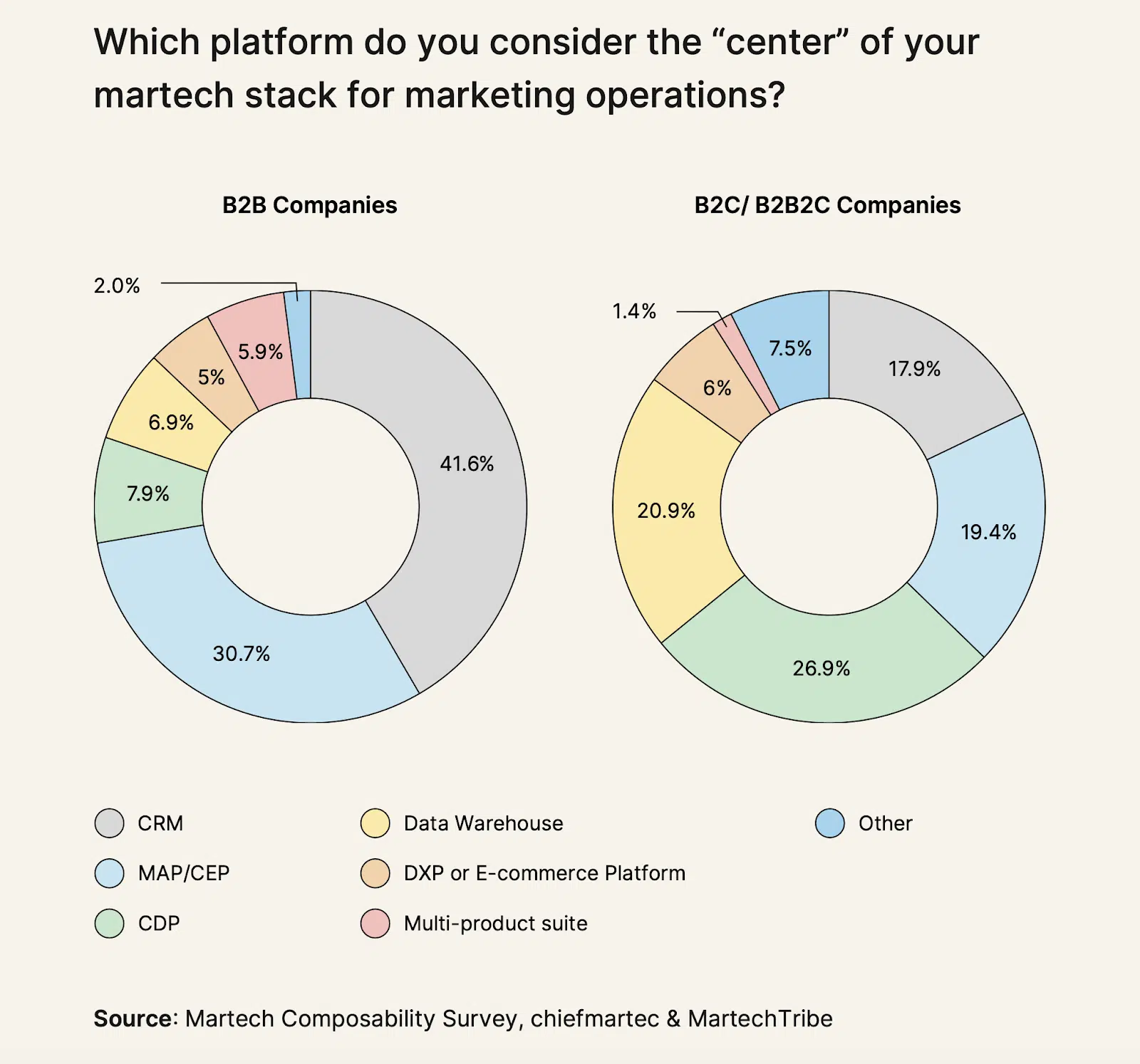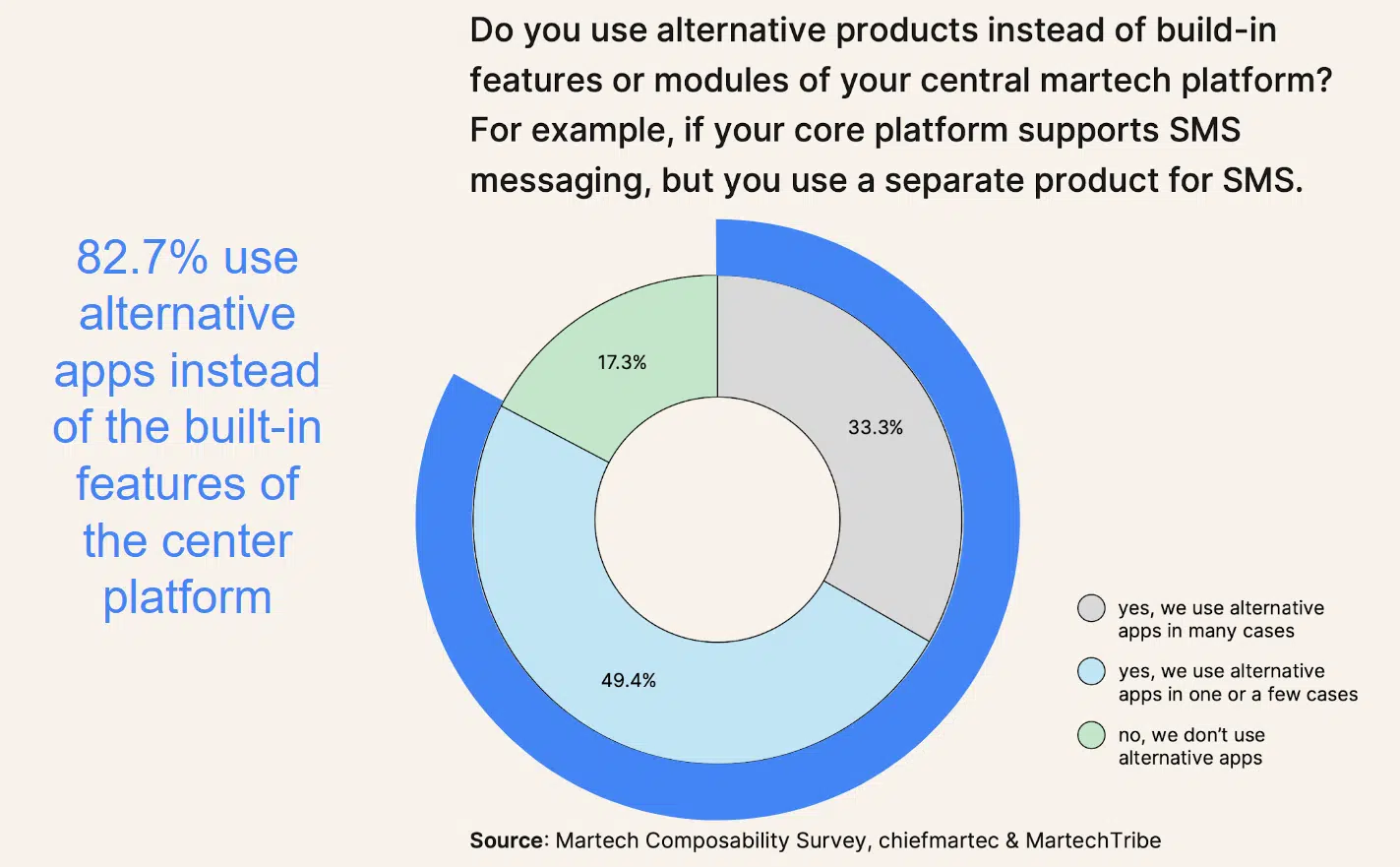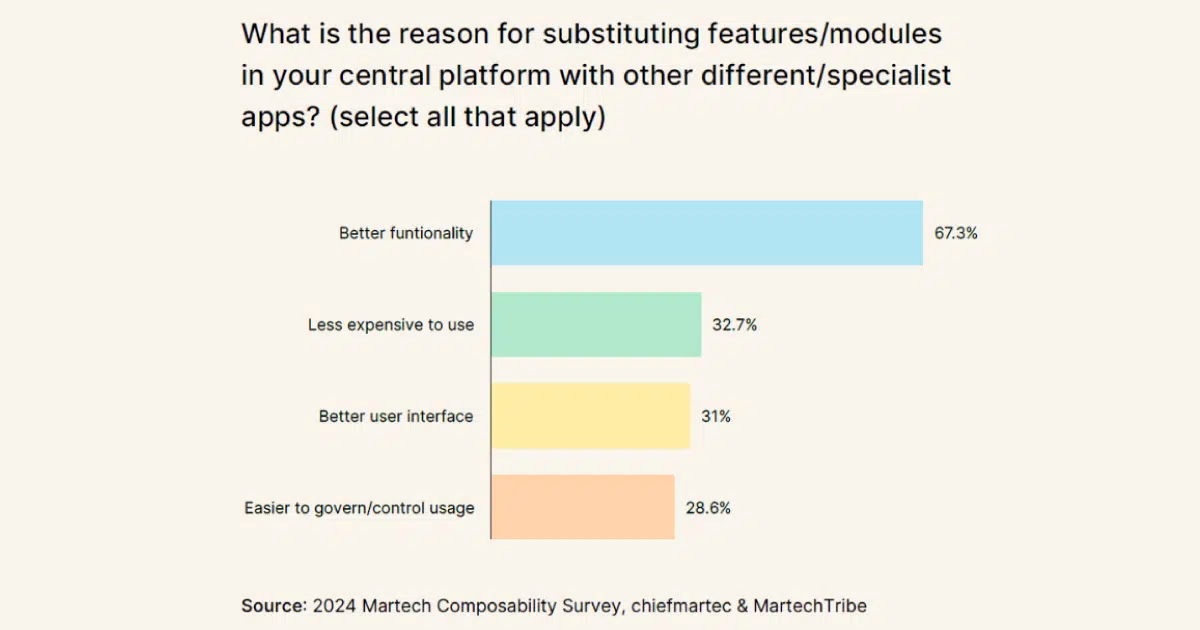The martech landscape has long been caught between two competing narratives: the promise of all-in-one marketing suites and the flexibility of point solutions. But there is a more nuanced reality that challenges both these perspectives. Composability, it turns out, isn’t just a buzzword or a strategy — it’s the actual practice of successful companies navigating the complex world of marketing technology.
Crafting a unified martech strategy
How we use martech is not the same as how we purchase martech. This is the simple conclusion of research of 1,500 martech stacks conducted by chiefmartec and MartechTribe. For decades, multi-product marketing clouds/suites have been presented as “the single source of truth” or “the one tool that replaces all others.” It has not been successful because, to this day, IT departments point out that marketing teams create shadow IT and legacy systems by purchasing point solutions with the marketing credit card.
As counterintuitive as it may sound, our research shows that the marketing approach is a best practice that desperately needs corporate policy. Marketing needs speed and agility in an unpredictable environment where competition operates and customers change their brand preferences. IT departments need stable and scalable systems in a predictable environment. That is also a best practice.
The secret is to marry marketing and IT best practices in a joined martech policy. In many companies, we see that these best practices collide. In reality, they are complementary to each other.
IT and marketing must sit together and design the policy to get the full potential of their martech tooling. To do this, use the three composability principles that our research revealed.
- Find the center platform in your stack to scale: Use center platforms to “run the business.”
- Experiment with specialist apps to stay relevant: Build prototypes that “change the business.”
- Implement a handover process: Implement design rules for migrating successful prototypes to the core stack.
1. Find the center platform in your stack
Our research shows companies are using a center platform in their stacks. Up to 72% of the 168 respondents say their center platform integrates with more than 50% of the other tools in their stack. Integrations are crucial for maintaining seamless customer interactions. If customer data is gold, then integrations are silver.
Only 4.2% said multi-product marketing clouds/suites are used as the central platform of their martech stack. If you imagine the high IT investments in software suites for marketing, that is a shockingly low percentage. This suggests companies don’t use suites for what they were purchased for.
This does not mean they do not use multi-product marketing suites at all. They use one module as their center platform but not necessarily the rest of the suite. Our study reveals that stacks have different center platforms. Across the board, CRM, MAP, CDP and CDW (cloud data warehouses) are considered the center of their martech stack.


The company business model defines the preferences for one of these tools. B2B companies prefer CRM and MAP, whereas B2C companies favor CDP or CDW as the center platform. In B2B, we need a lot of data about a small group of people. In B2C, we need a little data about a lot of people. This does not mean that B2C companies do not need a CRM. They just do not regard it as leading their stack.
The center platform is (most probably) managed and maintained by your IT department. Their task is to run the business that supports the current revenue streams. They keep the stack tooling stable, performant and scalable, with as little maintenance as possible. You probably have guessed by now what tool the center of your stack is in your company.
Dig deeper: How marketers can reinvent the IT-marketing dynamics
2. Experiment with specialist apps
Solutions labeled as “point solutions that create legacy and data dead ends” are, in fact, “specialist apps that prevent legacy that integrate well.” Specialist apps help companies stay relevant and drive future revenue. Our data shows that center platforms and specialist apps live together in stacks, even with overlapping capabilities and functionality.
About 83% of the respondents indicate they use alternative products instead of built-in features of their center platform. That is a percentage too large to be a coincidence. Let’s zoom in on why companies duplicate features and modules.


Contrary to conventional wisdom, our research shows that companies intentionally duplicate features to achieve better cost efficiency, governance, user experience and functionality. Companies duplicate features by design.
- Cost efficiency: Out-of-the-box specialist apps are cheaper than rolling out comparable center platform functionality, considering the configuration, maintenance and training efforts.
- Better governance: Switching on and off a specialist app is easier than the center platform modules. That prevents IT from overhauling the core platforms for one of the many experiments needed to find future revenue. Legal compliance, however, is an often overlooked issue here. It should be part of your martech policy.
- Better user experience and functionality: Specialist apps offer better features and interfaces because this is all they do as specialists. In other words, all their resources and R&D funds are invested in one job to be done. It is simply not feasible for large solutions to be everything to everyone.


Marketers like you probably select specialist apps. Your task is to change the business by finding new or improved viable business cases and experimenting with customer use cases. You might want to involve your legal experts to ensure you comply with the legal compliance regulations.
3. Implement a handover process
Since we need center platforms and specialist apps, we must establish rules for the handover from marketing to IT.
- Once your prototype yields a viable business case, the first rule is to clean it up and remove all redundant content, data and features. Leave out anything that does not break the business case.
- The second step is to brief IT and hand over the cleaned-up prototype.
- The IT department has three options:
- Migrate the prototype capabilities to the center platform.
- If the prototype capabilities are not in the center platform, integrate the specialist app into the core stack.
- If the prototyped specialist app is not compliant with IT standards, find an alternative specialist app that is.
Design a martech policy based on three composability principles
A corporate martech policy is based on the “composability” principles. “Composability” in martech refers to the flexibility of combining different tools to create something new, much like Lego blocks.
This isn’t a novel concept; IT has long embraced composability through open-source projects and modular software designs using libraries, objects, classes, agents, etc. Composability enables tailored solutions that meet specific customer and company needs rather than relying on one-size-fits-all platforms.
A good martech policy supports three competencies every company should develop.
- Hack: Rapid prototype specialist apps and finding viable business cases.
- Pack: Apply and update design rules for migrating viable prototypes to the core stack.
- Stack: Update your core stack.
Our findings show composability is not a strategy but a practical, proven, long-standing, effective approach to managing martech stacks. The martech landscape continually evolves, and we have learned that composability is at its core. Embrace this reality and leverage the flexibility of specialized tools to create a robust, efficient martech stack.
Dig deeper: How to boost operational maturity with strategic martech selection
Contributing authors are invited to create content for MarTech and are chosen for their expertise and contribution to the martech community. Our contributors work under the oversight of the editorial staff and contributions are checked for quality and relevance to our readers. The opinions they express are their own.
























































![Key Metrics for Social Media Marketing [Infographic] Key Metrics for Social Media Marketing [Infographic]](https://www.socialmediatoday.com/imgproxy/nP1lliSbrTbUmhFV6RdAz9qJZFvsstq3IG6orLUMMls/g:ce/rs:fit:770:435/bG9jYWw6Ly8vZGl2ZWltYWdlL3NvY2lhbF9tZWRpYV9yb2lfaW5vZ3JhcGhpYzIucG5n.webp)



















